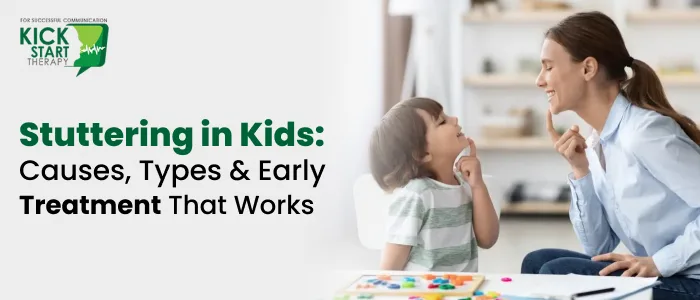
Stuttering, or stammering, is a common speech disorder that can affect the clarity, rhythm, and flow of a child’s speech. It often starts with a quiet pause, like a word stuck on the tip of the tongue. You might notice your child’s lips moving without sound, a look of effort in their eyes. What first seems like shyness or a passing phase can turn into moments of frustration or hesitation.
stammering in children can affect their inner confidence, like how they see themselves, how they interact with the world, and how they are perceived by others. But the good news? It is a condition that can be understood, supported, and guided toward progress with the right care and insight.
In this guide, we will learn the causes, types, and treatments of stuttering in kids, not just clinically, but emotionally. We will also discuss the symptoms of stammering and when is the right time to get professional help. So, let’s get started!
What is Stuttering Disorder?
Stuttering disorder is a speech condition where a person has trouble speaking smoothly. It causes interruptions in speech, like repeating sounds, syllables, or words, stretching out sounds, or pausing when trying to speak. These disruptions can make it hard for children to communicate easily.
Stammering often starts in childhood, usually between ages 2 and 5, when children are learning to speak. It affects about 1% of adults and is more common in boys than girls. The exact cause is not fully known, but it may involve genetics, brain differences, or challenges with speech coordination. Stress or anxiety can make speech disorder worse, but they do not cause it.
People who stutter may feel frustrated or embarrassed, which can affect their confidence. However, stuttering does not impact intelligence or abilities.
How Common is Stuttering?
In Canada, stuttering is relatively common, affecting people of all ages and backgrounds. Research shows that about 1% of Canadian adults stutter, which means roughly 400,000 people in a population of 40 million. Among children, the rate is higher, with around 5% experiencing stuttering at some point, especially between ages 2 and 5 when speech develops.
Boys are more likely to stutter than girls, with a ratio of about 4:1. While many children outgrow speech disorder naturally, about 1 in 5 continue to stutter into adulthood. The condition varies in severity, with some people experiencing mild disruptions and others facing more significant challenges in daily communication. Stammering appears across all cultural and linguistic groups, including English, French, and Indigenous communities.
What are the Symptoms of Stuttering?
Stuttering disrupts the flow of speech due to involuntary muscle movements in the face, mouth, throat, or chest. These disruptions can affect how smoothly a child communicates.
Below are the key symptoms used to identify speech disorder, along with related characteristics. Understanding these symptoms can help parents recognize stuttering and seek appropriate support.
Key Symptoms of Stuttering
To diagnose stammering, a healthcare provider typically looks for at least one of the following signs:
- Repeating Sounds or Syllables: Children may repeat the initial sound or syllable of a word, such as saying “b-b-ball” or “s-s-sun,” until they can complete the word.
- Prolonging Sounds: A child might stretch out a sound or syllable, like saying “sssssunday” instead of “Sunday.”
- Pausing Within Words: Unnecessary pauses may occur in the middle of a word, disrupting the flow, such as “ap—ple” instead of “apple.”
- Speech Blocks: A child may stop speaking abruptly, either silently or with filler sounds like “uh” or “um,” as if their words are stuck.
- Switching Words: To avoid speech disorder, a child might replace a difficult word or phrase with an easier one.
- Excessive Emphasis: Some children put too much force or tension on certain sounds or words, making their speech sound strained.
- Repeating Short Words: Single-syllable words like “a,” “and,” or “is” may be repeated multiple times before moving on.
Additional Characteristics
Children who stutter may also show or experience the following:
- Spillover Movements: The muscle tension from stuttering can spread to other areas, causing involuntary movements in the face, neck, or shoulders, such as twitching or shrugging.
- Related Habits: Kids may develop physical habits when stuttering, like excessive blinking, head tilting, or fist clenching, which may intensify during moments of difficulty.
- Emotional Triggers: Stammering often worsens when a child is tired, nervous, excited, or under pressure. It may improve when they are calm or well-rested.
- Context-Specific Fluency: Stuttering typically does not occur during activities like singing, reading aloud, or talking to pets or objects, where speech flows more naturally.
What are the Different Types of Stuttering?
There are three main types of stuttering, each with unique features. Understanding them can help people recognize and support those who stutter.
Developmental Stuttering
This is the most common type, often seen in young children aged 2 to 6 as they learn to speak. Kids may repeat sounds, syllables, or words, like saying “b-b-ball.” It usually happens when their speech skills are developing faster than their ability to control them. Most children outgrow this with time or with help from a speech language pathologist (SLP).
Neurogenic Stuttering
This type occurs after a brain injury or condition, such as a stroke or head trauma. It affects the brain’s ability to coordinate speech, causing pauses, repetitions, or prolonged sounds. It can happen in adults or children and may need medical and speech therapy support.
Psychogenic Stuttering
This is rare and linked to emotional stress or trauma. It may cause sudden speech disruptions, like blocking or repeating sounds. It is more common in adults and often improves with counseling or therapy to address the underlying emotional causes.
What Causes Stuttering?
While the precise cause behind stuttering remains under investigation, researchers point to a combination of factors that may contribute to its development.
Genetic Influence
A family history of stuttering significantly increases the likelihood of its occurrence. If a close relative, such as a parent or sibling, stutters, an individual’s risk may be elevated threefold. Specific genetic variations are also being studied for their role in stuttering, potentially affecting whether the condition persists or resolves over time.
Neurological Factors
Differences in brain structure and function are often observed in individuals who stutter. These variations typically involve regions responsible for coordinating speech muscles or regulating speech flow. Such neurological distinctions may disrupt the seamless interaction required for fluent speech.
Some believe ADHD is a primary cause of stammering. While ADHD is not a direct cause, there is a notable connection with a higher prevalence of stammering among individuals with ADHD. This link suggests shared neurological or developmental pathways, though more research is needed to clarify the relationship.
Other Contributing Elements
Beyond genetics and brain structure, environmental and developmental factors may cause temporary speech disorder. For instance, high-pressure speaking situations or early childhood speech development challenges could exacerbate stuttering tendencies in predisposed individuals.
What is the Best Treatment for Stuttering?
Finding the best treatment for stammering depends on the child’s age, needs, and the severity of stammering. Here are some effective approaches.
- Speech Therapy: Working with a speech-language pathologist is one of the most common and effective treatments. They teach techniques like slow speech, breathing exercises, and ways to control speech rhythm. These methods help improve fluency and build confidence in speaking.
- Cognitive Behavioral Therapy (CBT): Stuttering can cause anxiety or fear of speaking. CBT helps individuals manage these feelings by changing negative thoughts and building self-esteem. This is especially helpful for adults and older children.
- Support Groups: Joining a support group allows people who stutter to share experiences and practice speaking in a safe environment. This builds confidence and reduces feelings of isolation.
- Technology and Devices: Some tools, like speech apps or devices that provide feedback, can help improve fluency. These are often used alongside speech therapy for better results.
- Family Support: For children, parents are their greatest supporters. They can create a calm speaking environment, listen patiently, and work with therapists to support progress.
When Should You Seek Help?
Early intervention is crucial for children who stutter, as it can significantly improve their speech and confidence. Stammering often begins between the ages of 2 to 5, when speech development is rapid.
Addressing it early can prevent long-term challenges. If a child repeats sounds, prolongs words, or shows frustration while speaking for more than six months, parents should seek help from a speech-language pathologist. These professionals assess the child’s speech and design tailored therapy to promote fluent speech.
Early intervention reduces anxiety, builds self-esteem, and helps children communicate effectively. Acting promptly ensures better outcomes, making professional support essential for young children who stutter.
Conclusion
Stuttering in kids is a unique challenge that shapes how they express themselves, often sparking curiosity and concern among families. This blog sheds light on the diverse causes behind it.
It also highlights effective treatments to help children find their voice with confidence. Understanding these aspects empowers parents to nurture their child’s growth holistically.
Stammering in young kids often goes away on its own without any formal intervention. Around 75-80% of children who stutter recover naturally, usually within the first few years, often before age 5. But it’s tricky to know which kids will outgrow it, so professional assistance is still recommended.
Kick Start Therapy offers a caring, expert-led approach with speech therapists who create personalized plans to boost communication skills.
FAQs
How to Stop Stuttering from Anxiety?
Stuttering can get worse when you are anxious, but there are ways to ease it. Take slow, deep breaths before speaking to calm your nerves. Practice speaking in a relaxed setting with friends or family, and try simple exercises like reading aloud slowly. Avoiding stress triggers, like rushing, helps too. If it persists, talking to a speech therapist can teach you techniques to manage anxiety and improve fluency.
What’s the Difference Between Stammering and Stuttering?
Stammering and stuttering are pretty much the same thing; both describe trouble speaking smoothly, with repeated sounds or pauses. The terms are used differently based on where you are; “stammering” is common in the UK, while “stuttering” is more commonly used in the US. They both involve similar challenges, like blocks or prolongations, and affect communication in the same way.
Does a Stutter Ever Go Away?
Yes, for many kids, a stutter can fade away on its own, especially if it starts young, about 75-80% outgrow it by age 5 with support. But it depends on the cause; some may need help if it is linked to deeper issues. With therapy support, many see improvement, though it might not fully disappear for everyone.
Is Having a Stutter a Disability?
A stutter isn’t a disability on its own, but it can be considered one if it seriously affects daily life, like talking at school or work. It is recognized as a condition needing support, like extra time for speaking tasks. With the right help, many manage it well and lead full lives.
Is Stuttering a Form of ADHD?
No, stuttering isn’t a form of ADHD, though both can show up together. ADHD affects focus and behavior, while speech disorder is about speech flow. Some kids with ADHD might stutter due to impulsivity, but they are separate conditions. A professional can check if both are present and suggest tailored support.
Is Stuttering a Type of Autism?
Stuttering isn’t a type of autism, but some kids with autism may stutter because it can affect communication and coordination. Autism is a broader developmental condition, while stuttering is a speech issue. They can overlap, so if you notice both, a specialist can assess and guide you on the best help.
